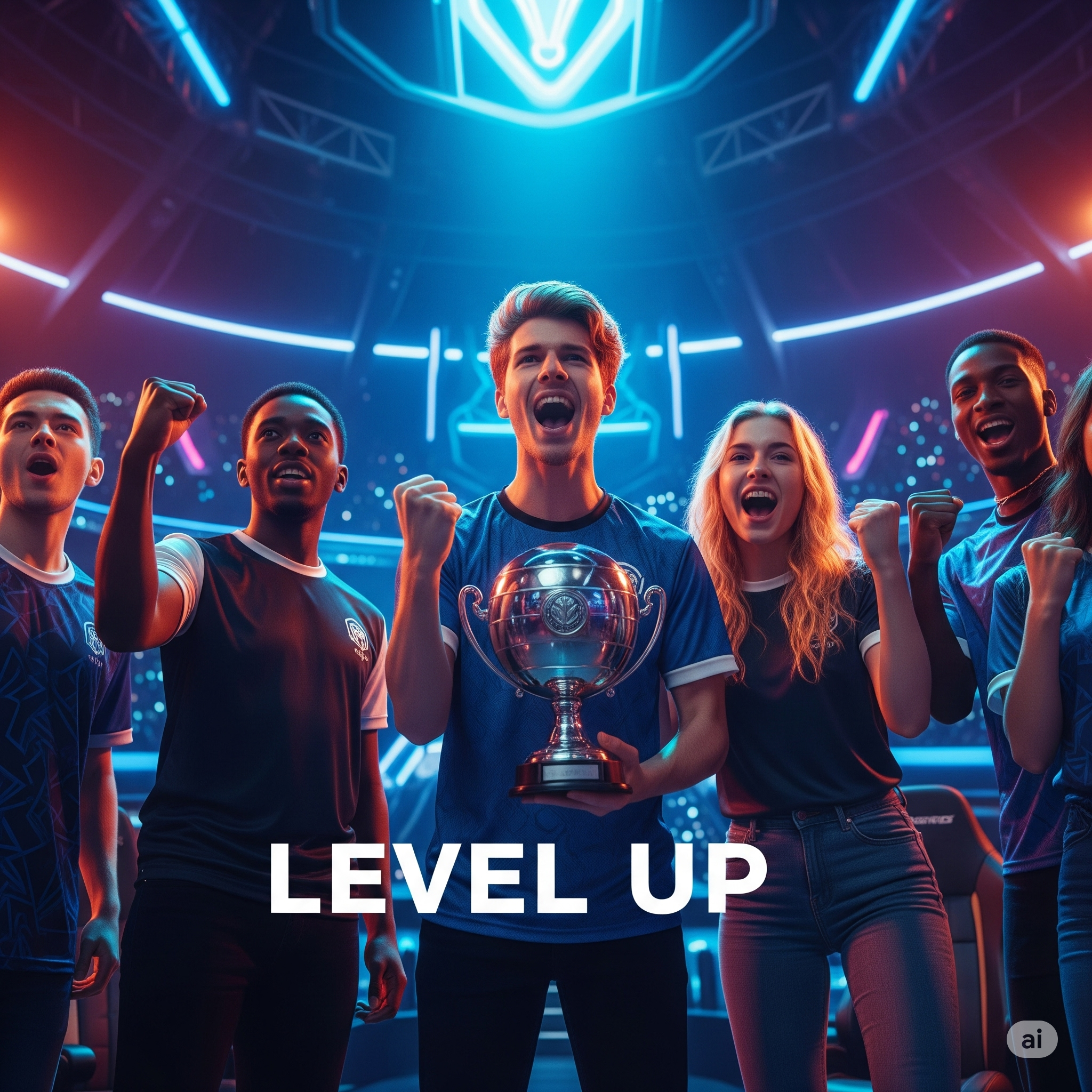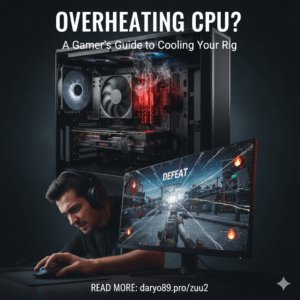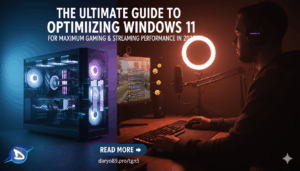Level Up Your Esport Team: The daryo89.pro 7-Pillar Framework for Competitive Gaming Success
Introduction: The Chasm Between Talent and Triumph in Modern Esports
The global esports landscape is no longer a niche hobby; it is a burgeoning professional industry characterized by explosive growth and escalating stakes. Projections indicate the global market will surge from $2.0 billion in 2023 to an astonishing $13.7 billion by 2032, propelled by a global audience expected to exceed 620 million unique viewers in 2024 alone. This rapid professionalization has created a formidable chasm between raw player talent and sustained, top-tier success. The days when mechanical skill and countless hours of grinding were the sole determinants of victory are over. Today, winning requires more.
The central thesis of this report is that the widening gap between amateur passion and professional contention can only be bridged by constructing a holistic, evidence-based ecosystem around the players. Success in modern esports is a multifaceted challenge that demands a strategic approach encompassing everything from player psychology and physical conditioning to data analytics and technical infrastructure. The amateur team that relies solely on in-game practice will inevitably be outmaneuvered, outlasted, and outperformed by organizations that treat their operations as a high-performance business.
To navigate this complex environment, this report introduces the daryo89.pro 7-Pillar Framework for Competitive Gaming Success. This framework is a comprehensive, integrated roadmap designed to guide teams through the process of professionalization. Each pillar addresses a critical domain of team management and performance optimization, providing actionable, research-backed strategies. This guide is built upon a foundation of deep technical expertise, directly reflecting the core competencies of daryo89.pro’s parent company, MY LITTLE LORD LTD, which is officially registered for “Information technology consultancy activities”. This report will serve as an exhaustive blueprint for any team serious about transcending the amateur leagues and establishing a lasting presence in the competitive gaming world.
Pillar 1: Forging a Winning Culture: The Unseen Architecture of a Champion Team
In the high-pressure environment of competitive gaming, team culture is not a “soft skill” or a vague aspiration; it is the fundamental operating system that dictates performance. Research into the psychology of esports athletes reveals a landscape fraught with intense stressors. Amateur and professional players alike report immense pressure from a variety of sources: “Team Pressure,” the desire not to let teammates down; “Stakes Pressure,” tied to prize money and rank; and “Social Pressure,” stemming from the awareness of being watched and scrutinized. This is compounded by the pervasive toxicity that can exist in online gaming communities, an element that, if left unmanaged, can easily infiltrate and poison a team’s internal dynamics, leading to tilt, blame, and eventual collapse.
The surface-level symptoms of a dysfunctional team—poor communication, unresolved arguments, inconsistent performance under pressure—are often rooted in a deeper structural failure. These issues can be understood through the lens of established management theory, such as the “5 Dysfunctions of a Team”: Absence of Trust, Fear of Conflict, Lack of Commitment, Avoidance of Accountability, and Inattention to Results. In an esports context, an Absence of Trust means players are unwilling to be vulnerable or admit mistakes. This leads to a Fear of Conflict, where crucial in-game feedback is withheld to avoid arguments. This, in turn, fosters a Lack of Commitment, as players do not feel they have truly bought into the team’s strategies. An Avoidance of Accountability follows, where poor play or bad attitudes are not called out. Ultimately, this culminates in an Inattention to Results, where individual egos or priorities supersede the collective goal of winning.
The solution is not reactive firefighting but proactive cultural engineering. A team must consciously and deliberately build its identity. This begins with establishing a Team Creed or a shared vision. This process involves asking foundational questions: What is our team’s personality? Are we ruthless dominators or a fun, community-focused group? What are our non-negotiable values regarding practice, communication, and sportsmanship?.
This creed becomes more than just a mission statement; it evolves into a functional management system. By establishing an objective set of standards and values, the team creates a foundation of trust and psychological safety. It transforms the nature of feedback. A critique is no longer a personal attack (“You played that poorly”) but an objective observation measured against the team’s agreed-upon standards (“That play didn’t align with our creed of disciplined aggression”). This framework depersonalizes criticism, enabling the healthy, constructive conflict necessary for growth and adaptation. The manager’s role shifts from being a mediator of personal disputes to an architect and guardian of this cultural system, fostering it through clear communication and consistent leadership. This structured approach is the most effective antidote to the five dysfunctions and provides the resilience needed to withstand the immense psychological pressures of competitive play.
Pillar 2: The Holistic Athlete: A Regimen for Peak Human Performance
The romanticized image of a gamer fueled by energy drinks and surviving on minimal sleep is a relic of a bygone era. In the modern professional scene, such a lifestyle is a direct path to physical injury, mental breakdown, and career-ending burnout. The physical and mental toll of elite esports is severe and well-documented. Physically, players are susceptible to a range of musculoskeletal issues, from “gamer’s thumb” and carpal tunnel syndrome to chronic neck and back pain, all stemming from repetitive motion and long hours in a sedentary position.
Even more alarming are the statistics on mental health. A landmark 2024 study of professional Counter-Strike players revealed that 25.5% reported moderately severe or severe symptoms of depression, and a staggering 72.5% reported low mental well-being. These figures are drastically higher than those found in the general population and even among traditional elite athletes. The same study highlighted a critical failure in the esports ecosystem: while the need is immense, only 13% of players reported being offered mental health support by their teams.
These physical and mental challenges are not separate issues; they are intertwined in a vicious cycle. Nutritional neglect and a lack of physical exercise are directly correlated with mood disturbances and depression. The immense stress and anxiety of competition, in turn, lead to poor sleep, unhealthy eating habits, and a disinclination to exercise, creating a downward spiral that culminates in burnout, a recurring theme that forces many talented players into early retirement.
To break this cycle, teams must adopt a proactive, holistic approach to player well-being, treating their athletes not as gamers but as high-performance human beings. This regimen is a direct investment in a team’s most valuable assets, with a clear return in the form of enhanced performance, career longevity, and roster stability.
A Blueprint for Well-being
- Physical Conditioning: A structured physical training program is non-negotiable. This must include aerobic exercises like running or cycling to build endurance for long tournament days; flexibility and mobility work, such as yoga or targeted stretching, to prevent stiffness and repetitive strain injuries; and strength training to support posture and fortify the small muscles of the hands and wrists. Improved physical fitness is directly linked to enhanced cognitive function, faster reaction times, and greater resistance to stress.
- Nutritional Strategy: Teams must move beyond simply avoiding junk food and implement a strategic approach to nutrition. This involves ensuring players consume regular, balanced meals to maintain stable blood sugar levels, which is crucial for sustained focus and cognitive performance during long practice sessions and matches.
- Sleep Hygiene: Sleep is not downtime; it is one of the most powerful performance-enhancing and recovery tools available. Establishing strict sleep hygiene—consistent sleep schedules, creating a restful environment, and avoiding screens before bed—is critical for cognitive restoration, emotional regulation, and physical recovery.
- Mental Health Infrastructure: Building a robust mental health support system is paramount. This goes beyond simply reacting to crises. It means providing proactive access to sports psychologists and licensed therapists who understand the unique pressures of the esports environment. It involves training players in mental resilience techniques like mindfulness, meditation, and Cognitive Behavioral Therapy (CBT) to manage performance anxiety and negative self-talk. Most importantly, it requires fostering a team culture where discussing mental health and seeking support is destigmatized and encouraged.
Ultimately, investing in a holistic athlete program—complete with physical trainers, nutritionists, and mental health professionals—is not an operational expense. It is a core strategic investment in risk management and performance optimization. A healthy player is a more resilient, focused, and effective competitor with a longer and more valuable career.
Pillar 3: The Science of Strategy: Implementing a Data-Driven Coaching Ecosystem
The path to improvement in esports is no longer paved with brute-force grinding. The traditional mentality of simply playing more hours hits a point of diminishing returns. Research confirms that at the elite level, the sheer quantity of practice time explains only a very small fraction of actual in-game performance. This highlights a critical need for a more intelligent, efficient, and evidence-based approach to training—a methodology known as “deliberate practice.” This shift places the modern esports coach at the center of a sophisticated, data-driven ecosystem.
The value of a contemporary coach extends far beyond in-game knowledge. While a deep understanding of the game is a prerequisite, the coach’s primary function is to act as a translator, converting raw, quantitative data into effective, human-centric pedagogy. They must bridge the gap between statistical analysis and practical player development.
The Modern Coach’s Toolkit
- Data-Driven Analysis: The foundation of modern coaching is analytics. Coaches must leverage game data to track Key Performance Indicators (KPIs) such as win rates, kill-death ratios, accuracy percentages, objective control, and other game-specific metrics. This data is not just for post-game analysis; it is used for comprehensive player performance evaluation, in-depth opponent scouting to identify tendencies and exploit weaknesses, and dynamic strategy development. Top-tier organizations like Team Liquid have even adopted AI-powered systems for advanced pattern recognition and predictive analytics, showcasing the future of strategic preparation.
- Scientific VOD Review: Video on Demand (VOD) review sessions must evolve from simple playbacks into structured, analytical inquiries. A coach guides the team to dissect gameplay, focusing not just on what happened, but why it happened. This involves analyzing team communication patterns, evaluating the quality of decision-making under pressure, and breaking down the execution of specific tactics.
- Personalized Development Plans: The true power of data is realized when it informs individualized training. A coach uses performance analytics to pinpoint specific weaknesses in each player’s game—be it mechanical skill, positioning, or decision-making. They then design customized training plans and targeted drills to address these deficiencies efficiently. This transforms generic practice time into a highly focused and purposeful process, maximizing the return on every hour spent training.
The Human Element of Coaching
While data provides the “what,” the coach provides the “how.” One of the greatest challenges in esports coaching is that elite players are often highly skilled, autonomous learners who have developed their abilities through thousands of hours of self-directed play and may be unfamiliar or even resistant to structured pedagogical methods. A coach cannot simply dictate orders based on a spreadsheet. They must be a leader, a mentor, and a motivator who can create a positive and collaborative learning environment.
The coach’s role is to create synergy, not just to retrain players on game basics. They must use data not to command, but to persuade and facilitate. By presenting objective evidence of a performance gap, a coach can collaboratively build a plan with the player, fostering buy-in and a sense of ownership over their development. This ability to translate data into actionable, engaging, and personalized coaching is the hallmark of an elite esports coach and the key to unlocking a team’s full potential.
Pillar 4: The Digital Arena: Engineering the Optimal Practice and Competition Environment
To achieve professional-level consistency, teams must move beyond the ad-hoc setup of players competing from their individual homes. The establishment of a dedicated, standardized practice and competition space—an “Esports Lab” or “Arena”—is a critical step in professionalization. This controlled environment not only fosters a more serious and focused team culture but also eliminates performance variables, ensuring that practice is productive and player evaluation is fair.
This process begins with a significant investment in standardized hardware. An uneven playing field where one player has a high-end PC and another has a 5-year-old machine makes it impossible to conduct meaningful practice or run fair tryouts. Performance will be skewed by technical disparities rather than skill. Therefore, defining and acquiring a baseline of competitive equipment is foundational.
Table 1: Foundational Esports Lab Hardware Specifications
| Component | Minimum Competitive Spec | Recommended Pro Spec | Rationale / Impact on Performance |
| CPU | AMD Ryzen 5 / Intel Core i5 (latest gen) | AMD Ryzen 7 / Intel Core i7 (latest gen) | A powerful CPU is critical for maintaining high, stable frame rates, which directly impacts gameplay smoothness and reduces input lag. The Pro spec ensures no bottlenecks, even when running demanding background applications. |
| GPU | NVIDIA GeForce RTX 4060 / AMD RX 7600 | NVIDIA GeForce RTX 4070 Ti or higher | The GPU is the single most important component for rendering frames. A higher-end GPU allows for higher resolutions and graphical settings without sacrificing the high refresh rates essential for competitive play. |
| RAM | 16 GB DDR4/DDR5 | 32 GB DDR5 | 16 GB is the minimum for modern gaming. 32 GB provides significant headroom, preventing stutters and ensuring smooth multitasking, which is crucial for players who may also be streaming or running analysis software. |
| Monitor | 24-27″, 1080p, 144Hz, <4ms response | 24-27″, 1080p/1440p, 240Hz+, <1ms response | Higher refresh rates (Hz) provide smoother motion clarity, allowing players to track targets more accurately. A low response time minimizes ghosting and motion blur. 240Hz is the modern competitive standard. |
| Mouse | Lightweight, >16,000 DPI, 1000Hz polling rate | Lightweight, >25,000 DPI, 4000Hz+ polling rate | A high polling rate reduces the delay between physical movement and cursor response. A lightweight, ergonomic design reduces fatigue during long sessions. Low-latency wireless is a viable pro-level option. |
| Keyboard | Mechanical (switch type per player preference) | Mechanical with low-latency optical or hall effect switches | Mechanical keyboards offer superior tactile feedback and durability. Advanced switch technologies can reduce input latency even further, providing a marginal but potentially critical advantage. |
| Headset | Stereo, clear microphone with noise cancellation | 7.1 Surround Sound, broadcast-quality noise-canceling mic | Clear audio is vital for hearing in-game cues (e.g., footsteps) and for unambiguous team communication. Noise cancellation on the mic ensures callouts are not obscured by background noise. |
The Physical Environment: Controlling the Controllables
Beyond the hardware itself, the physical environment must be meticulously engineered to support performance and well-being.
- Ergonomics and Wire Management: High-quality, ergonomic chairs and adjustable desks are essential to mitigate the physical strain of long practice hours. A clean, well-managed wiring setup is not just aesthetic; it prevents accidental disconnections and makes maintenance easier.
- Lighting and Acoustics: The lighting must be designed to reduce eye strain and eliminate monitor glare. Strategies include using gentle backlighting around monitors and carefully balancing natural and artificial light sources. The space should also be acoustically treated or soundproofed to minimize external distractions and prevent sound from one player’s headset from bleeding into another’s microphone, ensuring pristine team communication.
- Climate and Community: Adequate ventilation and temperature control are crucial for both player comfort and system stability, preventing hardware from thermal throttling under load. Furthermore, a well-designed facility should include spaces for community and rest. A separate lounge area with comfortable seating and large screens for VOD review or spectating encourages players to take necessary breaks from their screens while remaining engaged with the team, fostering social bonds and preventing burnout.
Pillar 5: The Millisecond Advantage: Mastering Network and System Latency
In the world of competitive esports, victory and defeat are often decided in fractions of a second. Latency—the delay between a player’s action and its appearance on screen—is not just a matter of feel; it is a quantifiable factor that directly impacts performance. Understanding and optimizing this “physics of performance” is one of the most significant competitive advantages a team can engineer. This requires a deep, technical approach that treats infrastructure not as a commodity, but as a core component of competitive strategy.
Latency is not a single number but a chain of delays. It includes input latency (from the mouse/keyboard), system latency (the PC’s processing time), and network latency (the time for data to travel to the server and back). Each link in this chain must be optimized. The impact of this optimization is not theoretical; it is proven by scientific research.
- A 2021 study on Counter-Strike: Global Offensive found that reducing network latency by 100 milliseconds resulted in a 2% improvement in player accuracy and an increase of 2 points per minute—roughly equivalent to an extra kill per minute, a massive advantage in a competitive match.
- NVIDIA research has demonstrated that improvements in system latency provide a clear benefit even at incredibly low values, well below 20 ms, debunking the myth of diminishing returns.
- Other studies have shown that for certain aiming tasks, increasing a monitor’s refresh rate from 60 Hz to 240 Hz can provide a more significant performance boost than a similar reduction in latency alone, highlighting the importance of smooth visual information.
This body of evidence transforms the vague notion that “low latency is good” into a hard, quantifiable competitive edge. This advantage is so critical that ensuring balanced latency among all competitors is considered essential to the very concept of fair competition. This has profound implications for amateur teams. An investment in optimized infrastructure is not merely about gaining an edge over opponents; it is a prerequisite for establishing
internal competitive integrity. Without a standardized, low-latency environment, a team cannot conduct meaningful practice, run fair tryouts, or accurately assess player performance, as results will be constantly skewed by technical disparities. This fundamental principle explains why so many high-stakes tournaments are plagued by technical pauses and controversies—they have failed to master this foundational pillar.
An Actionable Optimization Checklist
Achieving a low-latency environment requires a systematic, multi-layered approach:
- System-Level Optimization: This involves tuning the operating system for performance, ensuring all drivers (especially for the GPU) are up-to-date, disabling unnecessary background processes and overlays, and utilizing game-specific performance settings.
- Network Infrastructure: A wired network is non-negotiable. All gaming PCs must be connected via Cat6 or higher Ethernet cables to a high-performance gigabit switch. Wireless connections are unacceptable for competitive play due to their inherent instability and higher latency.
- Firewall and Router Configuration: This is where expert IT knowledge becomes indispensable. Teams must work with their IT administrators to implement critical configurations :
- Port Forwarding: Configure the network firewall to open the specific TCP/UDP ports required by each game title to ensure stable connections to game servers.
- Quality of Service (QoS): Implement QoS rules on the router to prioritize gaming traffic over all other network activity. This ensures that game data packets are not delayed by less critical traffic like web browsing or file downloads.
- Network Segmentation: For optimal performance, segment the gaming network from other traffic using VLANs (Virtual Local Area Networks). This creates an isolated “fast lane” for game data, protecting it from any congestion or interference from the broader school or facility network.
Pillar 6: The Streamer-Athlete Symbiosis: Optimizing for Flawless Gameplay and Broadcast
In the modern esports ecosystem, players are often more than just competitors; they are content creators. Streaming gameplay on platforms like Twitch and YouTube is a vital tool for building a personal brand, engaging with a fanbase, and attracting the attention of sponsors. However, this creates a significant technical conflict: competitive gaming demands every ounce of a PC’s resources to maximize frame rates and minimize latency, while live streaming is a separate, equally resource-intensive task that competes directly for that same CPU and GPU power. A poorly configured setup will result in either poor in-game performance (stuttering, low FPS) or a poor-quality stream (pixelation, dropped frames), compromising both the competitive and brand-building objectives.
The Single-PC Solution: A Cost-Effective Compromise
For many aspiring players and teams, a single PC must serve as both the gaming rig and the streaming machine. The key to making this viable lies in one critical technology: hardware encoding. Modern GPUs from NVIDIA (using the NVENC encoder) and AMD (using the VCE/AMF encoder) include a dedicated chip specifically for video encoding. By using a hardware encoder in streaming software like OBS or Streamlabs, the heavy lifting of the stream is offloaded from the CPU to this specialized chip. This frees up the CPU to focus almost entirely on running the game, dramatically reducing the performance impact of streaming.
Beyond hardware encoding, further software-level optimizations are crucial. This includes setting the streaming software’s process to “High” priority in the Windows Task Manager, closing all non-essential background applications before going live, and potentially lowering some in-game graphical settings to create more performance headroom for the stream.
Table 2: Recommended Streaming Encoder Settings (OBS/Streamlabs)
| Quality Target | Resolution | FPS | Bitrate (kbps) | Encoder | Key Settings / Notes |
| 720p Stable | 1280×720 | 60 | 3,500 – 4,500 | Hardware (NVENC/AMF) | An excellent balance for streamers with limited upload bandwidth. Provides a smooth 60 FPS experience without requiring a very high bitrate, reducing the risk of buffering for viewers. |
| 1080p High Quality | 1920×1080 | 60 | 6,000 – 8,000 | Hardware (NVENC/AMF) | The standard for high-quality streaming. Requires a stable internet connection with at least 10 Mbps upload speed. The 8,000 kbps cap is the maximum allowed by platforms like Twitch for non-partners. |
The Dual-PC Solution: The Professional Standard
For top-tier professionals and any organization where broadcast quality is paramount, the dual-PC setup is the gold standard. In this configuration, one PC is dedicated exclusively to gaming, running the game with zero compromises. The video output from this gaming PC is sent via an internal or external capture card to a second, dedicated streaming PC. This second machine handles all the intensive tasks of encoding the video, managing stream overlays, and broadcasting to the internet. While this setup involves greater cost and complexity, it completely eliminates the performance conflict, guaranteeing the best possible experience for both the player and the audience.
Finally, a professional broadcast is about more than just a stable frame rate. Investing in a quality webcam (1080p, 60fps), a clear USB or XLR microphone with a pop filter, and good three-point lighting elevates a stream from a simple gameplay capture to an engaging and professional production. This higher production value is more appealing to viewers and significantly more attractive to potential sponsors.
Pillar 7: The Sustainable Team: Navigating the Business of Esports
The final and perhaps most challenging pillar for any aspiring team is sustainability. The path from amateur to professional is littered with teams that possessed immense talent but ultimately disbanded due to financial instability. The harsh reality of the esports economy is that it is incredibly difficult for teams themselves to be profitable. Even at the professional level, many players are paid less than minimum wage, and the career path is fraught with high risk and a significant chance of failure. The core issue is a flawed business model: for years, many esports organizations have functioned more as marketing vehicles for game publishers than as self-sustaining, profitable entities.
For an amateur or semi-pro team to break this cycle and achieve long-term viability, it must undergo a fundamental paradigm shift. The primary objective must evolve from simply winning matches to building a marketable brand. A team’s record is fleeting, but a strong brand with a compelling story and an engaged community is a durable asset. The case study of Nerd Street Gamers provides a powerful example: by focusing on a narrative around the growth of amateur esports and building a strong community, the startup transformed itself into a “highly visible media darling,” attracting the attention of major investors and partners.
This is where the entire 7-Pillar Framework culminates. It is not just a guide to winning games; it is a comprehensive blueprint for building a sustainable and marketable esports organization. Each of the preceding six pillars contributes directly to the team’s value proposition and brand equity. A team that can demonstrate a professional culture, a commitment to player health, a data-driven coaching methodology, top-tier infrastructure, and a high-quality broadcast is infinitely more attractive to sponsors and investors than a group of talented but disorganized players.
A Blueprint for Sustainability
- Define Your Brand Identity: This process starts with the work done in Pillar 1. The team’s creed, its personality, its values, and its unique style of play are the foundational elements of its brand story.
- Identify Your Value to Sponsors: The primary value a team offers to sponsors is access to the highly coveted and notoriously hard-to-reach Millennial and Gen Z demographics, who have largely abandoned traditional media. A team’s brand is the vehicle for a sponsor to connect with this audience authentically.
- Develop Professional Assets: A team must be able to present itself professionally. This includes creating a sponsorship deck that tells the team’s story, provides detailed audience demographics, and outlines clear activation opportunities (e.g., jersey logos, sponsored stream segments, social media campaigns).
- Implement Basic Financial Management: As a team begins to generate revenue from winnings or sponsorships, it must operate like a business. This includes setting up a dedicated business bank account, meticulously tracking all expenses (tournament entry fees, travel, equipment), and establishing a clear system for managing payroll and prize money distribution.
Ultimately, the journey to professional esports requires a team to become more than just a team; it must become a business. By systematically implementing the seven pillars of this framework, an organization builds not only a winning roster but also a compelling brand and a viable commercial enterprise.
Conclusion: Your Path to the Next Level with daryo89.pro
The journey from a talented group of players to a successful, sustainable esports organization is a complex and demanding endeavor. As this report has detailed, modern competitive gaming requires a holistic, integrated approach that extends far beyond the game itself. Success is built upon seven critical pillars: a resilient and proactive Culture, the physical and mental well-being of the Holistic Athlete, a data-driven Coaching Ecosystem, an optimized Digital Arena, a mastery of Network and System Latency, a flawless Streamer-Athlete Symbiosis, and a viable plan for a Sustainable Team.
Raw talent may open the door to competition, but it is the mastery of these interconnected domains that will lead to championships and create a lasting legacy. Bridging the chasm between amateur passion and professional triumph requires more than just hard work; it requires expert guidance, strategic planning, and a deep understanding of the technical, psychological, and business challenges involved.
Implementing this 7-Pillar Framework is a resource-intensive process that can overwhelm even the most dedicated team managers. This is where expert partnership becomes invaluable. daryo89.pro offers the specialized advisory services necessary to help your team navigate this complexity. For any team or organization that is serious about leveling up its operations and competing at the highest level, the next step is clear.
A consultation can provide a tailored assessment of your team’s specific challenges and a roadmap for implementing this framework effectively. To begin your journey toward professional success, schedule a free, no-obligation consultation with daryo89.pro.











Add comment
You must be logged in to post a comment.